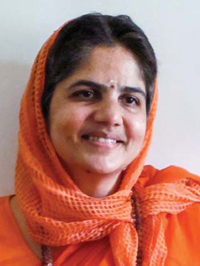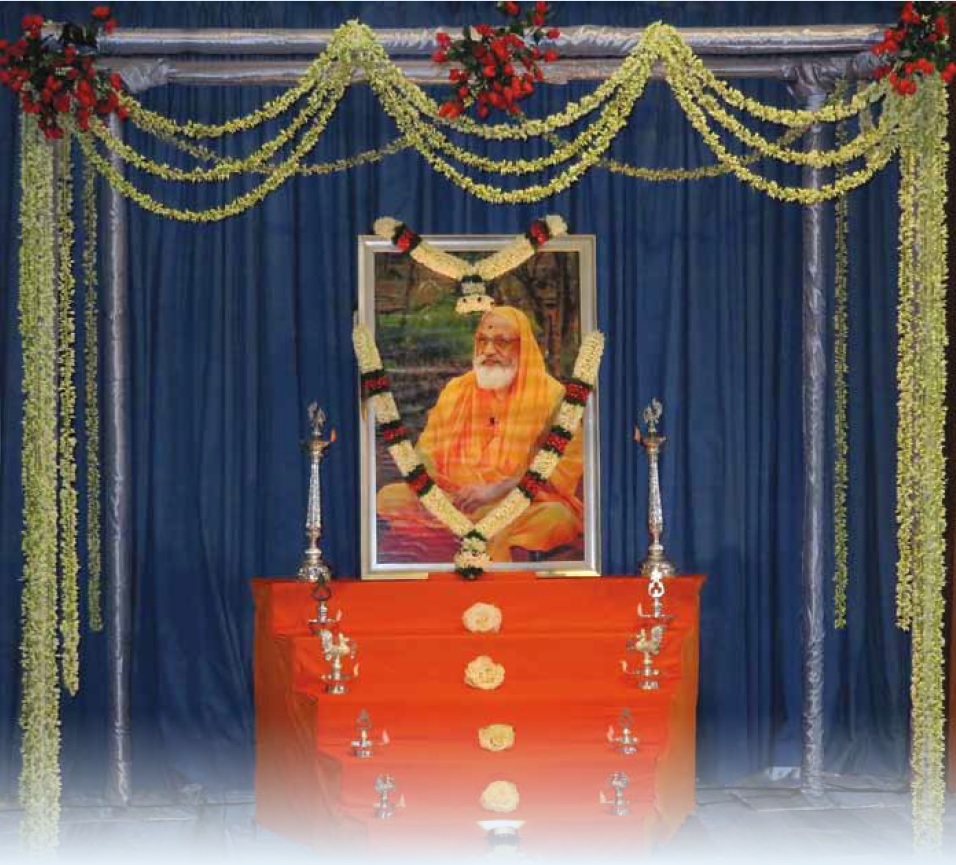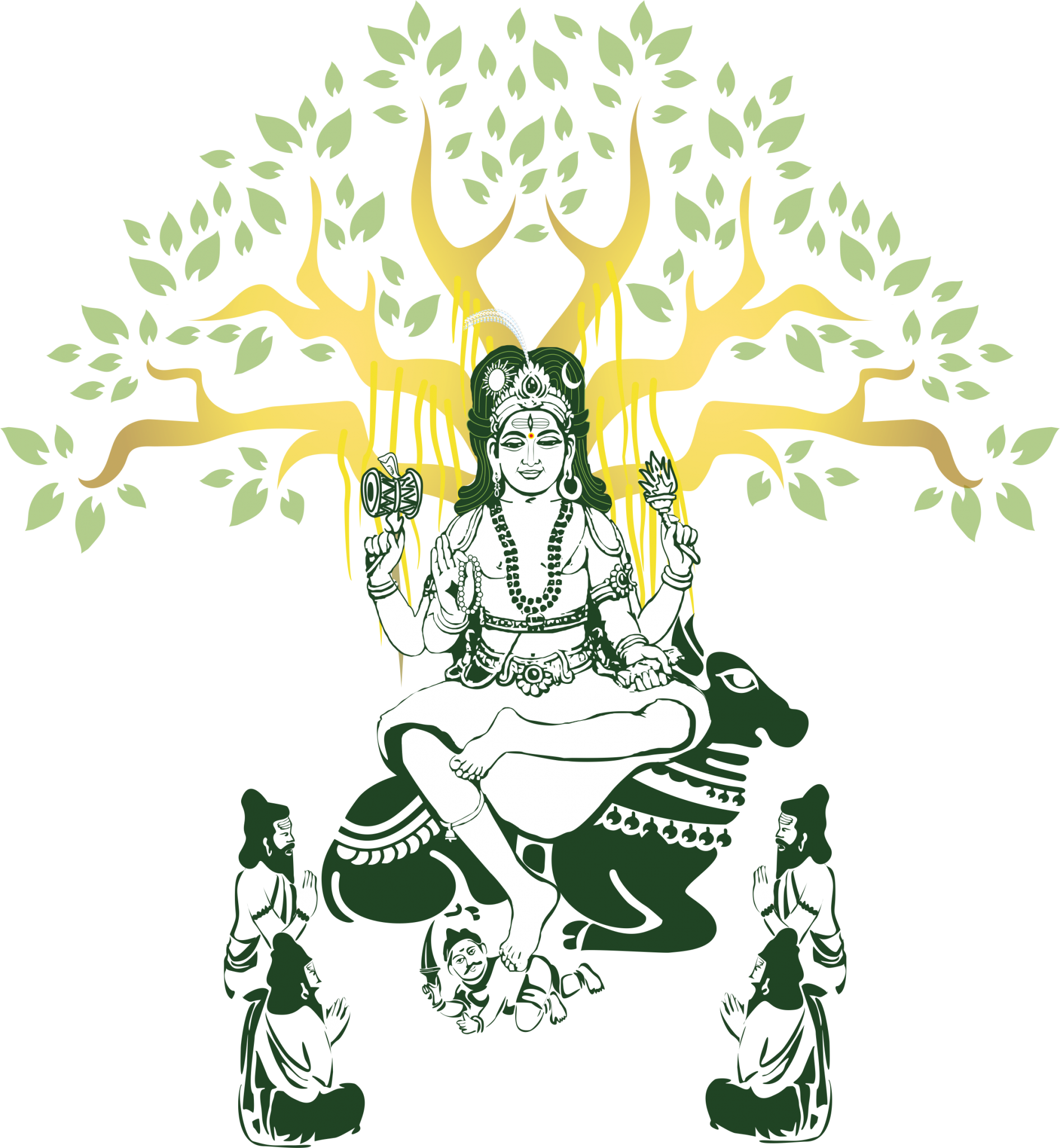Tributes by Swamini Svatmavidyananda

At the very outset, one feels like saying “What are we going to do now?” It is never easy to experience the loss of anyone, what to talk of a shining sun like Pujya Swamiji. However, Pujya Swamiji is not lost – there is no coming or going.
I’m reminded of the verse in the Bhagavad Gītā where Lord Krishna tells Arjuna, for that which is born, death is certain, and for that which has come to an end, birth is certain. When we talk of certainty, it means we are talking about a law. What dies is meant to die. We are not talking about the “I” the ātman, but about the perishable body, mind, and senses. This is the law of the universe. Whenever we are confronted with a loss of this magnitude, we are forced to return to the truth of the Śāstra. The Śāstrasays that while the body-mind-complex is very much finite and subject to end, there is no birth and no death, because the “I” is just using the body as a casing. Lord Krishna tells Arjuna that the body is like a cloth, an old torn t-shirt, that no one mourns for. In fact, one can’t wait to go shopping to get a new one because this one is not serving the purpose any longer!
When the person departs from the body we don’t say there is just the physical body. The physical body is left behind for everyone to see, but there is also the sūkṣma śarīra, the subtle body comprising of the mind, all the rāga-dveṣās, subtle elements, etc. We don’t see it when prāṇa departs, but it is there. There is also a causal body, which is self-ignorance, which finances the travel of the subtle body in this and other worlds — the ignorance of not knowing oneself as limitless make one an inter terrestrial and weary traveler.
When the mahā-samādhi of a mahātmā takes place, the body is left behind for everybody to see. This gross body disintegrates and joins the gross elements. However, the subtle body of the jñānī, joins the subtle elements because there is no one to finance the trip, the causal body, the cause because of which the body is incarnated, is not there for the mahātmā. It is destroyed through the study and assimilation of the knowledge of Vedānta, which teaches that one is whole and limitless. Therefore, the financier of the trip — the causal body — is not there.
So how do we communicate with Pujya Swamiji now? That which was there for us to communicate with was “Bhagavān plus” — Bhagavān plus the body, plus the mind, plus the senses, plus the humor, plus the kindness — an infinitely compassionate plus, with a wonderful voice and an incredible mind. What is there after mahā-samādhi? There is a graduation that has to take place. In every loss, there is a gain. I can take the leap and now I communicate with Bhagavān. Pujya Swamiji is a mūrti of Bhagavān, upāsya-mūrti — a beloved incarnation. One may now sense a physical distance, but there is no distance from the standpoint of the heart, from the standpoint of oneself. This is one of the gains. It’s like learning a new language. Let us say that suddenly someone you adored, revered, and communicated with daily has moved to another country. Pujya Swamiji has moved to another realm of being where the language of communication is prayer.

This is what Pujya Swamiji talked about all his life, how to relate to Bhagavān. The most beautiful thing about assimilating this teaching is that now we have Swamiji himself to relate to. Even though he’s not physically here he continues to urge us to see this Bhagavān as something to relate to. In this way, the loss is sublimated into an enacted relationship with Pujya Swamiji — a personal relationship, which is what Swamiji gave everybody when he was alive. So now we can continue to feel alienated and abandoned, with chips on our shoulders, or we can see how to put into practice the teachings and use them to bridge the gaps that we have in our relationship with Bhagavān. Pujya Swamiji is one form of Bhagavān that we can fully relate to; we have seen him, we know him, and we adore him. Difficult as it is to deal with Pujya Swamiji’s departure from this world, we cannot overlook the blessing of being able to assimilate the teachings in a deeper way and grow in our niṣṭhā.
Simultaneously, one also has to take care of the grief that is there. Grief has to be processed. One can write it out, talk it out, paint it out. One can learn how to pray it out. Prayer is the language of communication, where there is no fear of being rejected. Bhagavān is not going to say “no,” just like Pujya Swamiji could never say “no.”
The first gain is that one is learning to relate to Bhagavān, and in the process, one is also assimilating the teachings. Another point to consider is spiritual growth. Because of being prayerful in this way, one is growing spiritually. One can grow into becoming more accommodative, less reactive, more compassionate and more secure. Pujya Swamiji was a very big crutch, and now that is it is gone – one has to grow into being a crutch-less person. We have been dealt an opportunity to let go of the crutches and to forge within ourselves that security and identity that we seek.
Yet another potential gain is a special way of being close to Swamiji by being close to the śāstra. I would suggest that everyone who can teach should catch some people and sit them down and teach them. To all seekers and students, I would say, catch hold of the teacher — you can catch hold of any teacher in the lineage because they will all be teaching the same thing that Pujya Swamiji taught –perhaps not in the same way, but it will definitely be the same thing.
In every loss there is gain — this is one of the many paradoxes of Vedānta. We have to grow to be the Pujya Swamiji that we wish to see. The seeds are already there, the path has been already been shown to us by Pujya Swamiji. In the life of any saint, you see that it has not been a picnic. You see that lives of saints are often fraught with early difficulties. The saintly person has “īśvarized” the pain and has outgrown its power over his or her life. The saint has become bigger than the problems he or she faces. This is what we clearly see and admire in Pujya Swamiji’s life. When we embrace difficulties, we see them as opportunities for growth and the way reveals itself. How fortunate are we to have had the glorious privilege of having a great mahātmā such as Pujya Swamiji, who is a constant source of inspiration, as our guru.
Om tat sat


